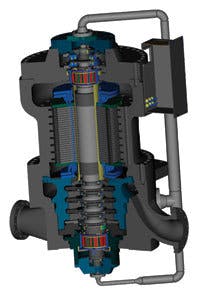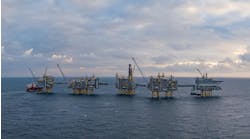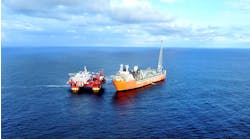FMC Kongsberg Subsea (FMC) and Siemens Power Generation PG have entered into an agreement to develop subsea gas compression technology. They believe the technology offers attractive benefits and that potential users are ‘just around the corner’. Potential users include Norsk Hydro and Statoil, which are both involved in projects to qualify the technology on the Norwegian shelf.
Subsea gas compression is part of the family of subsea processing technologies which is making an increasing impact on offshore oil and gas production. Other forms of subsea processing are already qualified for commercial use. Subsea multiphase pumping is already an established technology. FMC recently scored a notable achievement by winning a contract to supply the world’s first full-scale subsea separation system for Statoil’s Tordis field in the Norwegian sector. Elsewhere both Statoil and CNR Resources have plans to implement subsea water injection.
Subsea gas compression offers a cost-effective alternative to platform-based facilities, not least in deep waters and harsh environments. For example, it will allow gas to be pumped over long distances. One benefit will be to open up development of stranded gas fields far from infrastructure.
Siemens PG's Eco II compressor is an integrated electric motor seal-less centrifugal compressor.
Siemens PG expects subsea gas compression to bring possible savings of 30-40% compared with platform solutions, plus savings in personnel, in addition to providing safety and environmental advantages. It expects the market to grow fast in coming years, reaching in excess of 50 units in the mid term, according to Peter Adam, VP, oil and gas, industrial applications division.
Under the two companies’ cooperation agreement, Siemens PG, a supplier of compression equipment and systems, is responsible for developing the compressor technology and FMC, a contractor for subsea production systems, is responsible for marinizing it.
Minimized maintenance
Some serious challenges have to be overcome to take compression technology subsea. For example, intervention can only be carried out if the machine is retrieved to the surface. Therefore it must be able to function without intervention for long periods - the partners have set themselves the target of a minimum maintenance period of five years. In the case of malfunction, it is easier to retrieve part of the system than all of it - so a modular design is necessary.
The concept which best fits the demanding bill is Siemens PG’s Eco II compressor development. Eco II is an integrated electric motor seal-less centrifugal compressor. The motor is canned to keep it separate from the process gas, and a cooling medium will be used for cooling. The first Eco II compressor prototype has been developed in a project for Shell and is due to start pilot operations at an onshore plant this month.
Siemens PG has selected some of the critical component suppliers, though suppliers have yet to be selected for the magnetic bearings, high-voltage electrical connector, and variable speed drive. It is the marinization of the electrical equipment that represents the greatest challenge, Adam says.
The current development will use an AC power supply, which allows an envelope of operation up to 150 km, says Adam. Current technology makes it possible to supply up to 13-14 MW of power to operate subsea equipment.
FMC is probably the most experienced company in the world in supplying subsea processing systems, most of which are pressure boosting. It regularly uses Framo Engineering pumps in these deliveries, and has yet to suffer a failure due to pump malfunction, says Managing Director Tore Halvorsen. The Tordis subsea separation system which it has designed incorporates two pumps, each requiring 2.3 MW, which will be supplied as AC power via an electro-hydraulic umbilical over a distance of 12 km.
In 2000 FMC established a separate group to take charge of subsea processing technology, conducting client studies, and developing a product portfolio. The Siemens group has also set up an internal body to address the oil industry’s needs, known as the sector development board, oil and gas.
The full-scale subsea compression station planned by Hydro will weigh about 2,500 tons and have throughput capacity of 60 MMcm/d of gas and 45,000 b/d of condensate. The station, which will be installed in a water depth of around 850 m, will comprise four 12.5-MW compression trains.
Statoil plans to use subsea gas compression on Åsgard and Snøhvit. On Åsgard it sees a need for two 6- to 8-MW compression units installed in 250 m of water downstream of the Midgard field, which is a 50-km step-out from the host Åsgard B platform. Increased recovery is estimated at 30 bcm. On Snøhvit, which is due to come onstream in 2007, subsea compression is not expected to be required until around 2020. However, this is a long step-out, 143 km from the shore terminal.•




